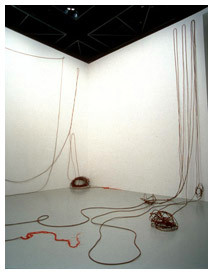


 |


launch interview with Sheila Gowda
Sheela Gowda's work occupies the spaces between painting, drawing, sculpture, and installation. Initially trained as a painter, Gowda underwent a profound transformation in the wake of fundamentalist Hindu violence and the Bombay riots of 1992. It was at this time that she abandoned conventional forms of painting and turned to sculpture and installation. She also made a dramatic shift in her choice of materials, incorporating into her work substances and processes from traditional Indian culture such as cow dung, which has sacred implications but is also used as a domestic cooking fuel and building material, and Kum Kum, a red dye used for body adornment and rituals. Consciously blurring the line between fine art and craft, and between creative, political, and domestic spaces, she makes formal investigations into the possibilities of contemporary art while also questioning the role of female subjectivity in the often volatile mix of religion, nationalism, and violence in contemporary Indian society.
Moving between two- and three-dimensionality, these works offer uniquely conceptual and formal challenges to the architecture of the gallery space while subtly evoking metaphors of loss and healing. Her work And Tell Him of My Pain (1998/2001), for example, can be read on many levels. Its snaking coils of glued and dyed thread and needles might bring to mind the pain of female domestic life in a patriarchal society, and at the same time it might be seen as a reference to the formal gestures of Jackson Pollock's drips or Eva Hesse's experiments in postminimalist sculptural form.
Indicative of this balancing act between form and content is Gowda's Private Gallery (1999/2000), a freestanding installation composed of two door-sized sheets of Formica attached to make a corner. Although the facade presents an industrially manufactured decorative surface, when one enters the "private gallery" by walking behind it, a completely different world is on view. The reverse side of this clean Formica structure is patterned with thumb-sized pats of cow dung that have been applied over a thin, painterly wash made of the same material. Attached to this surface is a sequence of watercolor renditions of people and places in the artist's home city of Bangalore, the Silicon Valley of India. In this work, as in the history of the hyperdevelopment of Bangalore itself, the urban and the rural come crashing together. Gowda's gallery offers a public and a private face to this onrush of globalization, being sure to humanistically honor (the mark of the hand with cow dung) those who are being displaced in the process.
Gowda has had a number of solo exhibitions since the late 1980s at, among other venues, Venkatappa Art Gallery, Bangalore (1993 and 1987); Gallery Chemould, Mumbai, India (1993) for Anatomy of Sacrilege; and Gallery 7, Mumbai (1989). Her work has also been included in group exhibitions such as Traditions/Tensions: Contemporary Art in Asia at the Asia Society, New York, New York (1996), and the Johannesburg Biennial, South Africa (1995).
--Douglas Fogle











